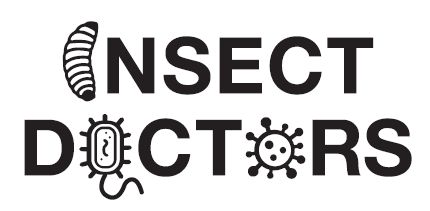WP3 Research Projects:
Increasing insect resistance against pathogens
The interactions between pathogens and the insect microbiome
and how nutritional adaptations can increase fitness of reared insects.
Project 11
Exploring nutritional adaptation of host-specific and generalist insect-pathogenic fungi
Natural host range, or the number of species a parasite is capable of infecting, varies considerably among insect-pathogenic fungi (IPF). The factors driving why some IPF are capable of infecting a large range of insects while others are limited to specific hosts is not well understood in the field of evolutionary ecology. My project will explore how key abiotic factors relate to host specificity using Metarhizium, a common rhizospheric entomopathogenic fungus and plant symbiont, and its insect host, mealworm (Tenebrio molitor) beetles.

PhD candidate
Anna Slowik
Supervisors
- Henrik de Fine Licht, University of Copenhagen (DK)
- Helen Hesketh, UK Centre of Ecology and Hydrology (UK)
- Steve Sait, University of Leeds (UK)
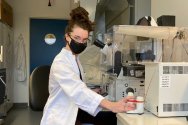
Outline
Environmental conditions and fungal characteristics such as nutritional acquisition, temperature optima, and response to short-term temperature stress all influence the evolution of host adaption in IPF. I will use three Metarhizium species and Tenebrio beetles as model organisms to examine the effects of temperature and nutrition on the growth of fungal species that have evolved different host ranges. Tenebrio are serious pests of stored grain products in many areas of the world but their larvae, mealworms, are also mass-produced for the food and feed industry. Metarhizium is an ideal model system for answering basic questions in ecology and speciation. As a genus, it has species that are globally distributed, lots of genomic resources have been established, and most importantly, Metarhizium species have very diverse host ranges. In my project, the diverging host ranges between these fungi will be studied in vivo and in vitro to determine thermal optima, optimal nutritional intake, and explore interactions between fungal diet quality, temperature, and virulence.
What makes this cryptic evolutionary phenomenon relevant? IPF are an important aspect of population control in natural insect populations. IPF are also relatively understudied. It’s estimated the biodiversity of IPF likely harbors one of the largest reservoirs of undocumented fungal species. Understanding the evolutionary relationship between IPF and insects is increasingly more important as insects has become a key source of protein massively produced for livestock and human consumption.
My work will be carried out in three phases and conducted primarily at the University of Copenhagen, as well as the University of Leeds and the UK Centre for Ecology & Hydrology. First, I will develop a somewhat novel approach to rapidly measuring fungal growth with spectrophotometry in small volume liquid media. This method will then be applied in an in vitro analysis to determine thermal and nutritional optima in three species of Metarhizium, which differ in their host specificity. Findings from the in vitro experiment will serve as a basis for the parameters of in-vivo experiments with live T. molitor. Conclusions drawn from the live insect model are intended to be used to discern the relationship between the evolution of host specificity and key abiotic factors, as well as make informed predictions for favorable insect production conditions to avoid fungal infections in the mass rearing industry.
Project 12
The role of microbiota in host resistance against bacterial and fungal pathogens in wax moths
Despite the growing body of information regarding microbial interactions in insects, there remains a key question that has not yet been addressed: what is the role of the gut microbiota in host resistance to pathogens in insects? Currently, it is unclear to what extent the gut microbiota contributes to- or decreases host resistance to pathogens; and if there are some indigenous isolates of the microbiota that may improve the immune response to pathogens.

PhD candidate
Jennifer Upfold
Supervisors
- Vincent Sanchis, INRAe (FR)
- Annette Bruun Jensen, Copenhagen University (DK)
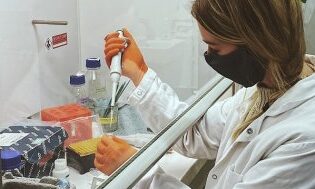
Outline
Conflicting opinions persist on the role of the gut microbiota in resistance to pathogens in insects. Nevertheless, it can be described as a “hidden” player due to its influence on the insects overall health and abilities. Therefore, further research into the role of the microbiota in host resistance and immunity from pathogens is required to grow expertise for maintaining insect health. Galleria mellonella (Lepidoptera: Pyralidae)larvae is chosen as the model organism for this study as the innate immune system has been widely studied for its response to both entomopahogens and human pathogens. A system of axenic rearing has also been established for this species. Insect pathogens generally have two routes of horizontal infection, oral via the gut and topical via the exoskeleton. By utilising pathogenic bacteria and fungi, the role of the gut microbiota can be assessed by both routes of infection. My research will observe several responses of the humoral and cellular immunity in both axenic* and conventionally* reared G. mellonella larvae, as well as characterise the microbiota during pathogen infection in single and co-infections from Bacillus thuringiensis (bacteria)and Metarhizium anisopliae (fungi). There will also be an assessment of important life history traits to determine trade-offs corresponding to the presence or absence of the gut microbiota when challenged by a pathogen. It is also our hypothesis that there are isolates of bacteria within the midgut that aids the immune response to help G. mellonella fight bacterial infection and mycoses. Understanding how and to what extent the immune response is mediated by the microbiota in single and co-infections will allow the potential for the development of probiotics and overall maintenance of insect health. The research will be conducted at INRAe in Jouy-en-Josas, France; and in the Department of Plant and Environmental Sciences at the University of Copenhagen, Denmark.
- *axenic – larvae reared in sterile conditions resulting in an absence of microbiota
- *conventional – larvae reared in normal conditions resulting in a presence of microbiota
Project 13
Food and probiotics in insect health and pathogen resistance
Diet composition is an important factor for insect development and the presence of probiotics in the microbial community present in the diet can protect different insects as bees and the yellow mealworm from pathogens. The role that probiotic bacteria and micronutrients play in enhancing insects’ fitness and immune responses in presence of pathogens infection needs more investigations.

PhD candidate
Carlotta Savio
Supervisors
- Christina Nielsen-LeRoux, INRAe (FR)
- Joop van Loon, Wageningen University (NL)

Outline
The number of insect’s mass rearing systems is developing in EU due to the increasing demand of sustainable protein sources. Several insect species as grasshoppers, crickets, mealworms and flies, has already been used as feed and food sources in Asian, African and south American cultures. EU is modifying the legislation in order to authorize some insects’ species in the western market. Tenebrio molitor, common yellow mealworm, has just been approved for being used as food ingredient by EFSA (https://efsa.onlinelibrary.wiley.com/doi/epdf/10.2903/j.efsa.2021.6343).
This insect is the model used in my project.
If present, undetected pathogens can be devastating to rearing facilities and their insects, resulting in growing economic losses. Potentially, probiotics and prebiotic-like micronutrients of a diet could manipulate the gut microbial communities of reared insects. This means that feed composition and probiotics could assist in insect wellbeing and increased immune responses and may, in this instance, aid Tenebrio molitor against bacteria and fungi like Bacillus thuringiensis and Metarhizium brunneum. Another burning question is if these two pathogens together would result in a stronger disease, or if they would compete with each other, potentially limiting the symptoms that could occur due to a co-infection.
The results from this project will give information to improve diet and probiotics that can be applied at the beginning of the lifecycle of Tenebrio molitor in order to enhance the fitness and the basal immune responses. This condition should decrease the losses in case of infections and should avoid the use of antibiotics in rearing systems.
In addition Tenebrio molitor could also be taken into consideration as an insect model organism for testing probiotics for animal systems.
The research project is part of the Marie Curie ITN European Insect Doctors Programme and it is taking place at INRAE at Jouy en Josas (FR), Wageningen University (NL) and Copenhagen University (DK).
Project 14
Microbiota mediated food protection against lepidopteran pathogens
Caterpillars are a nightmare for many farmers that have jeopardized agricultural systems worldwide, over many years. Synthetic insecticides to control them may fail due to the pests becoming increasingly resistant, and they negatively impact beneficial insects and the environment at large. Thankfully, biological control methods such as the use of pathogenic bacteria, fungi, and viruses have proven their efficacy. However, this efficacy varies with the different plants on which the caterpillars feed. Therefore, we need to investigate the link between the caterpillar diet and the infection process of microbial control agents.

PhD candidate
Loretta Mugo-Kamiri
Supervisors
- Elisabeth Herniou, CNRS (FR)
- Ben Raymond, University of Exeter (UK)

Feeding caterillars with virus-containing fluid
Outline
Research has shown that nutrition alters the gut microbiota of insects and, just like in human beings, this has a role to play in the insect’s response to pathogens. In some instances, gut microbiota protects insects against pathogens while in others, it facilitates pathogen infection. These interactions have been observed with baculoviruses and pathogenic bacteria as well, but the mechanisms behind the occurrences remain largely unknown. Therefore this study aims to investigate which key dietary components are responsible for significant changes in the gut microbiota, and how these positively or negatively affect baculovirus infection in the beet armyworm (Spodoptera exigua: Noctuidae).
Altogether, these results will integrate the interactions between the food, the microbiota, and the pathogens to understand how they a
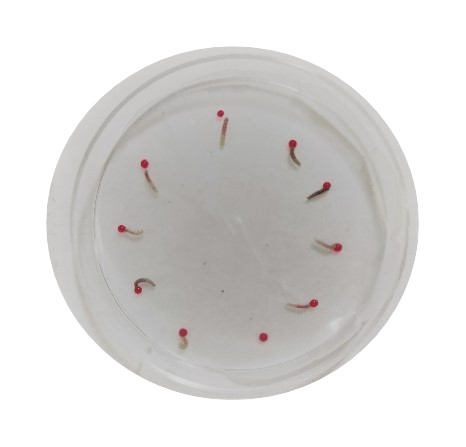
Ultimately, the knowledge obtained will be fundamental to tailoring new biological control applications that are effective regardless of the host plant species, and optimizing mass rearing of lepidopteran pests, especially where they are used for in vivo pathogen production.
For this project, I bring a varied skill set with my background in food technology, food safety, and nutrition. I have as well vast experience in working with insects, notably in vivo production of baculoviruses for the control of Helicoverpa armigera (Cotton bollworm) in East Africa and research in the edible grasshopper Ruspolia differens widely consumed in Uganda.
Project 15
Experimental evolution of insect gut symbionts to improve fitness under SIT and transgenic mass release
Aedes mosquitoes are vectors for several arboviruses, including those that cause dengue, chikungunya, yellow fever and Zika. The incidence of Aedes aegypti, and therefore the potential for disease transmission is increasing, due to climate changes and urbanization. Vector control strategies are also changing in order to respond to this challenge, and to replace ineffective chemical pesticides.

PhD candidate
Alessandro Roman
Supervisors
- Ben Raymond, University of Exeter (UK)
- Sander Koenraadt, Wageningen Univerity (NL)
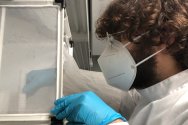
Outline
The sterile insect technique (SIT) and the related Incompatible Insect Technique (IIT) are two alternative genetic that rely on area wide inundative release of mosquito males in order to suppress vector populations and hence reducing the risks of mosquito-borne disease transmission. More specifically, SIT is based on release of sterilized mass-reared males (Fig 1), whereas IIT takes advantage of the cytoplasmic incompatibility conferred by a specific bacteria, Wolbachia. Many of these technologies rely on large scale production of sterile males or self-limiting transgenic insects https://www.iaea.org/sites/default/files/aedes-who-iaea-2020.pdf. These techniques should address one vital point for their success: mass-reared sterile males must be able to compete effectively with wild type males for wild type females.
In this project we will be exploring how we can use microbes to increase the fitness of male Aedes aegypti mosquitoes. Bacteria in gut microbiome can play an important role on affecting nutrient assimilation, growth rate and vector competence. The focal point of the research is to unearth gut bacterial symbionts that could act, both singularly or otherwise in “concert”, positively (as mutualists) in producing high-quality mass Aedes aegypti mosquitoes, improving the efficiency of rearing systems. In addition to the above, I will explore the effects of the selected bacterial symbionts on the mating competitiveness between bacterial treated and untreated males, in both small and large mating cages. Conventional, axenic and gnotobiotic mosquitoes rearing protocols, will allow us to compare the effects of putative mutualistic symbionts. Mosquito larvae are aquatic and can acquire bacteria directly by filter feeding in the breeding water. Improving the mating competitiveness of mass-reared males could result in a mass release of less individuals for vector control programs, that will bring more consensus between citizens and a reduction of insects’ production costs. Furthermore, by using transcriptomic facilities, we aim to investigate and understand the impacts of mutualistic associations on insect immunity, nutrition and gene regulation.
This project could achieve as output more knowledge and data that can be used to reduce vector borne disease outbreaks. Understanding the relationships between the bacterial gut community and the hosts should improve opportunities and alternative techniques for mass rearing systems and fighting vector populations, by analysing the different situations, national regulations, permits and ethics statements. The host institution for this research project is the University of Exeter (UK), and secondments are taking place at the Wageningen University (NL) and FAO (AU).
–
